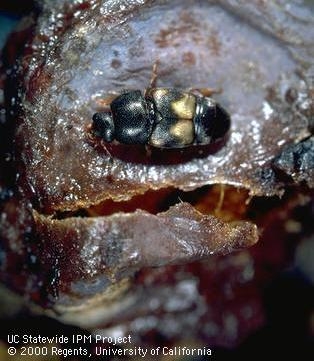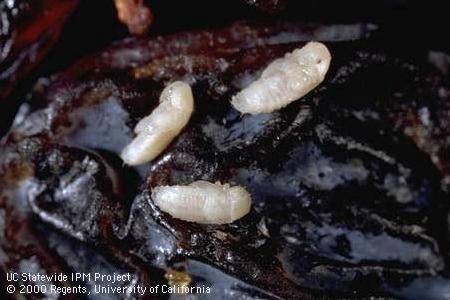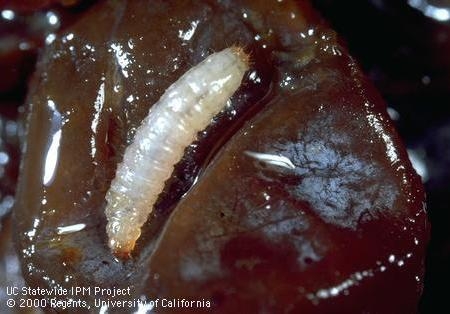The Driedfruit Beetle was observed infesting grape clusters last season at a couple of locations in eastern San Luis Obispo County beginning in late August. This beetle is an occasional pest in this area, and has not been commonly seen in most vineyards.
The Driedfruit Beetle is attracted to ripe and overripe fruit, particularly to grapes with bunch rot. Vineyards with rot-prone varieties such as Zinfandel, Petite Sirah and Grenache will be especially prone to damage from this pest, as will any variety that suffers from bunch rot due to botrytis, sunburn, mealybug feeding, etc.
The adult beetles are about 1/8" long and females lay about 1000 eggs each over the target fruit. The newly hatched pupae are a translucent yellowish color, and mature into a white larvae about 1/8" to 1/4" long having distinctive tan head caps and two horn-like structures on the posterior end. These larvae may be confused with the late generation larvae of the Omniverous Leafroller. Once mature the larvae enter the soil and pupate and later emerge as adults. The full life cycle can take about 3 weeks in warm weather. Adults can fly long distances; they have been measured to fly 2.5 miles in four days.
The feeding activity of the larvae as they develop within the cluster will rapidly increase the bunch rot problem and quickly degrade fruit quality even more. Growers with vineyards having some level of bunch rot should be on the lookout for the activity of the larvae in the clusters, and avoid unnecessary delays in harvest if significant activity is observed.
The activity of adults can be monitored with bait traps to indicate if the beetle is present in the area; information on using these traps is available from the UC IPM website for figs. The traps contain culled fruit, water and yeast. Larger numbers of these traps placed out earlier in the season may help control populations.
Management of this pest in vineyards is achieved primarily through cultural practices that reduce initial bunch rot in the first place and thus make the vineyard less attractive to the adult Driedfruit Beetles. Improving field sanitation by tilling under of rotting culled fruit may be advisable to minimize the build-up of pest populations that can move into later ripening varieties or over-winter in the area.


